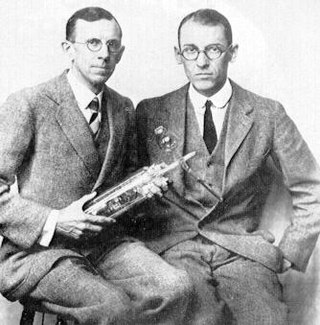Top Qs
Timeline
Chat
Perspective
Clinton Davisson
American experimental physicist (1881–1958) From Wikipedia, the free encyclopedia
Remove ads
Clinton Joseph Davisson (October 22, 1881 – February 1, 1958) was an American experimental physicist who shared the 1937 Nobel Prize in Physics with George Paget Thomson "for their experimental discovery of the diffraction of electrons by crystals."[1]
Remove ads
Biography
Clinton Joseph Davisson was born on October 22, 1881, in Bloomington, Illinois, the son of Joseph Davisson, an artisan from Ohio, and Mary Calvert, a schoolteacher from Pennsylvania.[2]
Davisson graduated from Bloomington High School in 1902, and entered the University of Chicago on scholarship. Upon the recommendation of Robert Millikan, he was hired by Princeton University in 1905 as an instructor in physics. He completed the requirements for his B.S. from Chicago in 1908, mainly by working in the summers. While teaching at Princeton, he did doctoral research under Owen Richardson, receiving his Ph.D. in 1911.[3][2]
After graduating, Davisson was appointed Assistant Professor of Physics at the Carnegie Institute of Technology. In 1917, he took a leave from the Carnegie Institute to do war-related research in the Engineering Department of the Western Electric Company. The same year, he joined the Technical Staff of Bell Telephone Laboratories, where he remained until his retirement in 1946. From 1947 to 1949, he was a visiting professor at the University of Virginia.[2]
Davisson died on February 1, 1958, in Charlottesville, Virginia, at the age of 76.[2][4][5]
Remove ads
Davisson–Germer experiment

Diffraction is a characteristic effect when a wave is incident upon an aperture or a grating, and is closely associated with the meaning of wave motion itself. In the 19th century, diffraction was well established for light and for ripples on the surfaces of fluids. In 1927, while working for Bell Labs, Davisson and Lester Germer performed an experiment showing that electrons were diffracted at the surface of a crystal of nickel. This celebrated Davisson–Germer experiment confirmed the de Broglie hypothesis that particles of matter have a wave-like nature, which is a central tenet of quantum mechanics. In particular, their observation of diffraction allowed the first measurement of a wavelength for electrons. The measured wavelength agreed well with de Broglie's equation , where is the Planck constant and is the electron's momentum.[6]
Remove ads
Family
While doing his graduate work at Princeton, Davisson met his future wife, Charlotte Sara Richardson, who was visiting her brother (and his doctoral advisor), Professor Owen Richardson.[7] Charlotte was the sister-in-law of Oswald Veblen, a prominent mathematician.[8] Clinton and Charlotte (d. 1984) married in 1911 and had four children:[9] Owen; James; Richard, who became a physicist; and Elizabeth.
Recognition
Awards
Memberships
Remove ads
See also
References
External links
Wikiwand - on
Seamless Wikipedia browsing. On steroids.
Remove ads





